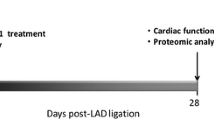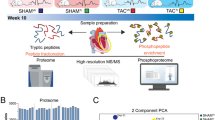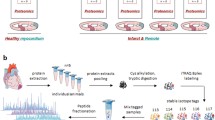Abstract
Angiotensin II (AngII) type 1 receptor (AT1R) blockers (ARBs) limit left ventricular (LV) dysfunction and necrosis after reperfused myocardial infarction (RMI) and proteomics can detect changes in protein levels after injury. We applied proteomics to detect changes in levels of specific protein in the ischemic zone (IZ) and non-ischemic zone (NIZ) of dog hearts after in vivo RMI (90 min of anterior ischemia; 120 min of reperfusion) and treatment with intravenous vehicle (control) and the ARBs valsartan or irbesartan (10 mg/kg) over 30 min before RMI. We also assessed LV function, infarction and apoptosis. Both ARBs limited the RMI-induced LV dysfunction, infarct size and apoptosis. Proteomics detected differential expression of 5 randomly selected proteins in the IZ compared to the NIZ after RMI: decrease in α subunit of ATP synthase isoform precursor (consistent with increased conversion to α subunit under metabolic stress), M chain creatine kinase (consistent with cellular damage) and ventricular myosin light chain-1 (consistent with structural damage and decreased contractility); and increase in NAD+-isocitrate dehydrogenase (ICDH) and α subunit and ATP synthase D chain (mitochondrial, consistent with metabolic dysfunction). Importantly, changes in NAD+-ICDH and ATP synthase D chain were reversed by ARB therapy. Thus, proteomics can detect regional changes in metabolic, contractile, and structural proteins after RMI and several of these proteins are favorably modified by ARBs, suggesting that they may be novel therapeutic targets. (Mol Cell Biochem 263: 179–188, 2004)
Similar content being viewed by others
References
Braunwald E, Kloner RA: The stunned myocardium: prolonged, post-ischemic ventricular dysfunction. Circulation 66: 1146–1149, 1982
Ganz P, Ganz W: Coronary blood flow and myocardial ischemia. In: E. Braunwald, D. P. Zipes, P. Libby (eds). Heart Disease 6th edn, Vol 2. Saunders, Philadelphia 2001, pp 1087–1113
Jugdutt BI: Effect of reperfusion on ventricular mass, topography and function during healing of anterior infarction. AmJ Physiol 272: H1205–H1211, 1997
Bolli R: Mechanism of myocardial stunning. Circulation 82: 723–738, 1990
Jugdutt BI, Khan MI, Jugdutt SJ, Blinston GE: Impact of left ventricular unloading after late reperfusion of canine anterior myocardial infarction on remodeling and function using isosorbide-5-mononitrate. Circulation 92: 926–934, 1995
Jugdutt BI, Schwarz-Michorowski BL, Tymchak WJ, Burton JR: Prompt improvement of left ventricular function and topography with combined reperfusion and intravenous nitroglycerin in acute myocardial infarc-tion. Cardiology 88: 170–179, 1997
Armstrong PW, Collen D: Fibrinolysis for acute myocardial infarction: current status and new horizons for pharmacological reperfusion, part 2. Circulation 103: 2987–2992, 2001
Yoshiyama M, Kim S, Yamagishi H, Omura T, Tani T, Yanagi S, Toda I, Teragaki M, Akioka K, Takeuchi K, Takeda T: Cardioprotective effect of the angiotensin II type 1 receptor antagonist TCV-116 on ischemia-reperfusion injury. Am Heart J 128: 1–6, 1994
Youhua Z, Shouchun X: Increased vulnerability of hypertrophied my-ocardium to ischemia and reperfusion injury. Relation to cardiac renin-angiotensin system. Chin Med J 108: 28–32, 1995
Jalowy A, Schulz R, D¨ orge H, Behrends M, Heusch G: Infarct size reduction by AT1-receptor blockade through a signal cascade of AT2-receptor activation, bradykinin and prostaglandins in pigs. J Am Coll Cardiol 32: 1787–1796, 1998
Jugdutt BI, Xu Y, Balghith M, Moudgil R, Menon V: Cardioprotection induced by AT1R blockade after reperfused myocardial infarction: As-sociation with regional increase in AT2R, IP3R and PKC proteins and cGMP. J Cardiovasc Pharmacol Therapeut 5: 301–311, 2000
Xu Y, Menon V, Jugdutt BI: Cardioprotection after angiotensin II type 1 blockade involves angiotensin II type 2 receptor expression and activa-tion of protein kinase C-å in acutely reperfused myocardial infarction. Effect of UP269-6 and losartan on AT1 and AT2 receptor expression, and IP3 receptor and PKC proteins. J Renin Angiotensin Aldosterone Syst 1: 184–195, 2000
Jugdutt BI, Balghith M: Enhanced regional AT2-receptor and PKC expression during cardioprotection induced by AT1-receptor blockade after reperfused myocardial infarction. J Renin Angiotensin Aldosterone Syst 2: 134–140, 2001
Jugdutt BI: Role of AT1 receptor blockade in reperfused myocardial infarction. In: N. S. Dhalla (ed). Signal Transduction and Cardiac Hy-pertrophy. Kluwer Academic Publishers, Boston, 2002, pp 221–236
Arrell DK, Neverova I, Van Eyk JE: Cardiovascular proteomics: Evo-lution and potential. Circ Res 88: 763–773, 2001
Xu Y, Kumar D, Dyck J, Ford WR, Clanachan AS, Lopaschuk GD, Jugdutt BI: AT1 and AT2 receptor expression and blockade after acute ischemia–reperfusion in isolated working rat hearts. Am J Physiol 282: H1206–H1215, 2002
Matsumura K, Jeremy RW, Schaper J, Becker LC: Progression of my-ocardial necrosis during reperfusion of ischemic myocardium. Circula-tion 97: 795–804, 1998
Criscione L, de Gasparo M, Buhlmayer P, Whitebread S, Ramjoue HP, Wood J: Pharmacological profile of valsartan: A potent, orally active, nonpeptide antagonist of the angiotensin II AT1-receptor subtype. Br J Pharmacol 110: 761–771, 1993
Culman J, von Heyer C, Piepenburg B, Rascher W, Unger T: Effects of systemic treatment with irbesartan and losartan on central responses to angiotensin II in conscious, normotensive rats. Eur J Pharmacol 367: 255–265; 1999
Balghith M, Jugdutt BI: Assessment of diastolic dysfunction after acute myocardial infarction using Doppler echocardiography. Can J Cardiol 18: 69–77, 2001
Sawicki G, Dakour J, Morrish DW: Functional proteomics of neurokinin B inthe placenta indicates a novel role in regulating cytotrophoblast antioxidant defences. Proteomics 3: 2044–2051, 2003
Perkins DN, Pappin DJ, Creasy DM, Cottrell JS: Probability-based pro-tein identification by searching sequence databases using mass spec-trometry data. Electrophoresis 20: 3551–3567, 1999
Laemmli UK: Cleavage of structural proteins during the assembly of the head of bacteriophage T4. Nature 227: 680–685, 1970
Moudgil R, Menon V, Xu Y, Musat-Marcu S, Kumar D, Jugdutt BI: Postischemic apoptosis and functional recovery after angiotensin II type 1 receptor blockade in isolated working rat hearts. J Hypertens 19: 1121–1129, 2001
McGregor E, Dunn MJ: Proteomics of heart disease. Hum Mol Genet 12: R135–R144, 2003
Comte B, Vincent G, Bouchard B, Benderdour M, Des Rosiers C: Reverse flux through cardiac NADP(+)-isocitrate dehydrogenase under normoxia and ischemia. Am J Physiol 283: H1505–H1514, 2002
Werrmann JG, Cohen SM: Comparison of effects of angiotensin-converting enzyme inhibition with those of angiotensin II receptor an-tagonism on functional and metabolic recovery in postischemic working rat heart as studied by [31P] nuclear magnetic resonance. J Cardiovasc Pharmacol 24: 573–586, 1994
Van Eyk JE, Powers F, Law W, Larue C, Hodges RS, Solaro RJ: Breakdown and release of myofilament proteins during ischemia and ischemia/reperfusion in rat hearts: Identification of degradation products and effects on the pCa-force relation. Circ Res 82: 261–271, 1998
McDonough JL, Arrell DK, Van Eyk JE: Troponin I degrada-tion and covalent complex formation accompanies myocardial is-chemia/ reperfusion injury. Circ Res 84: 9–20, 1999
Yang J, Moravec CS, Sussman MA, DiPaola NR, Fu D, Hawthorn L, Mitchell CA, Young JB, Francis GS, McCarthy PM, Bond M: De-creased SLIM1 expression and increased gelsolin expression in failing human hearts measured by high-density oligonucleotide arrays. Circu-lation 102: 3046–3052, 2000.
Rouet-Benzineb P, Buhler JM, Dreyfus P, Delcourt A, Dorent R, Peren-nec J, Crozatier B, Harf A, Lafuma C: Altered balance between matrix gelatinases (MMP-2and MMP-9)and their tissue inhibitors in human di-lated cardiomyopathy: potential role of MMP-9 in myosin-heavy chain degradation. Eur J Heart Fail 1: 337–352, 1999
Reinhardt D, Sigusch HH, Hensse J, Tyagi SC, Korfer R, Figulla HR: Cardiac remodelling in end stage heart failure: Upregulation of matrix metalloproteinase (MMP) irrespective of the underlying disease, and evidence for a direct inhibitory effect of ACE inhibitors on MMP. Heart 88: 525–530, 2002
Tyagi SC, Hayden MR, Hall JE: Role of angiotensin in angiogenesis and cardiac fibrosis in heart failure. In: N.S. Dhalla, P. Zahradka, I. Dixon, R. Beamish (eds). Angiotensin II receptor blockade: Physiological and Clinical Implications. Kluwer Academic Publishers, Boston, 1998, pp 537–549
Sawicki G, Menon V, Jugdutt BI: AT1 receptor blockade upregulates TIMP-3 and improves MMP-9/TIMP-3 balance during in vivo postis-chemic myocardial reperfusion. (Abstr) Circulation 108: IV–38, 2003
Charney RH, Takahashi S, Zhao M, Sonnenblick EH, Eng C: Collagen loss in the stunned myocardium. Circulation 85: 1483–1490, 1992
Spinale FG, Mukherjee R, Iannini JP, Whitebread S, Hebbar L, Clair MJ, Melton DM, Cox MH, Thomas PB, de Gasparo M: Modulation of the renin–angiotensin pathway through enzyme inhibition and specific receptor blockade in pacing-induced heart failure: II. Effects on myocyte contractile processes. Circulation 96: 2397–2406, 1997
Bolli R, Marban E: Molecular and cellular mechanisms of myocardial stunning. Physiol Rev 79: 609–634, 1999
Jugdutt BI: Ventricular remodeling postinfarction and the extracellular collagen matrix. When is enough enough? Circulation 108: 1395–1403, 2003
Author information
Authors and Affiliations
Additional information
An erratum to this article is available at http://dx.doi.org/10.1007/s11010-006-9338-9.
Rights and permissions
About this article
Cite this article
Jugdutt, B.I., Sawicki, G. AT1receptor blockade alters metabolic, functional and structural proteins after reperfused myocardial infarction: Detection using proteomics. Mol Cell Biochem 263, 179–188 (2004). https://doi.org/10.1023/B:MCBI.0000041860.97991.7a
Issue Date:
DOI: https://doi.org/10.1023/B:MCBI.0000041860.97991.7a




